人教新课标选修六 Unit 2 Poems-Using language[课件]
- 格式:ppt
- 大小:1.04 MB
- 文档页数:31
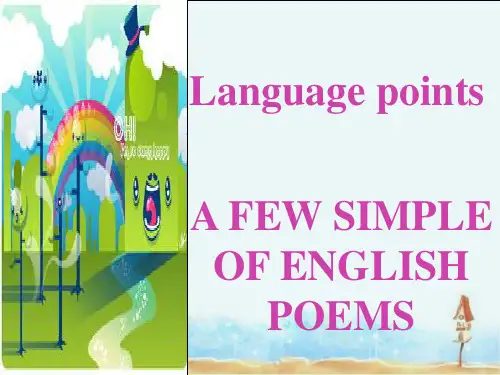
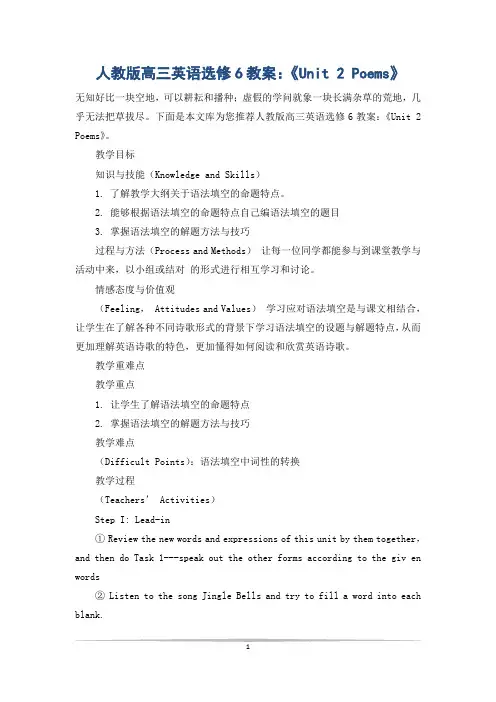
人教版高三英语选修6教案:《Unit 2 Poems》无知好比一块空地,可以耕耘和播种;虚假的学问就象一块长满杂草的荒地,几乎无法把草拔尽。
下面是本文库为您推荐人教版高三英语选修6教案:《Unit 2 Poems》。
教学目标知识与技能(Knowledge and Skills)1. 了解教学大纲关于语法填空的命题特点。
2. 能够根据语法填空的命题特点自己编语法填空的题目3. 掌握语法填空的解题方法与技巧过程与方法(Process and Methods)让每一位同学都能参与到课堂教学与活动中来,以小组或结对的形式进行相互学习和讨论。
情感态度与价值观(Feeling, Attitudes and Values)学习应对语法填空是与课文相结合,让学生在了解各种不同诗歌形式的背景下学习语法填空的设题与解题特点,从而更加理解英语诗歌的特色,更加懂得如何阅读和欣赏英语诗歌。
教学重难点教学重点1. 让学生了解语法填空的命题特点2. 掌握语法填空的解题方法与技巧教学难点(Difficult Points):语法填空中词性的转换教学过程(Teachers’ Activities)Step I: Lead-in① Review the new words and expressions of this unit by them together,and then do Task 1---speak out the other forms according to the giv en words② Listen to the song Jingle Bells and try to fill a word into each blank.1Step II : Pre-practising1. Questions① Do you think it is difficult to complete the items of blank-filling with grammar knowledge② Have you figured out the cha racteristics of the item2. ExplainingIn this item there are 10 blanks for you to fill in with less than one proper word① some blanks with a given word while others with none② fill in the blanks with the proper form of the give n word according to its grammatical and logical meaning.③ choose a preposition, pronoun, conjunction or an article to fill in the blank without any given word.3. DiscussionHow can we finish the items step by step with our grammar knowledge① ___________________________________________.② _ __________________________________________.③ ___________________________________________.Step III : While-practising1. Making an item of grammatical blank-filling based on the para graph of the text.① more than 5 blanks.② some blanks with given word.③ others with none.2. exchange the item you made for your partner to complete it .3. The whole class finis h the one the teacher prepared for them. Step IV : Post-practising1.Check some of the students’ anwsers and give comments.2.Draw a conclusion2Step V: Homework Assign ment1. Further improve your skills of dealing with the grammar filling.plete Ex.2 on Page 10, Nanfang New Class3。
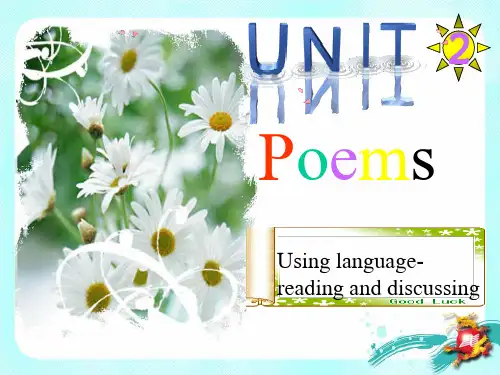
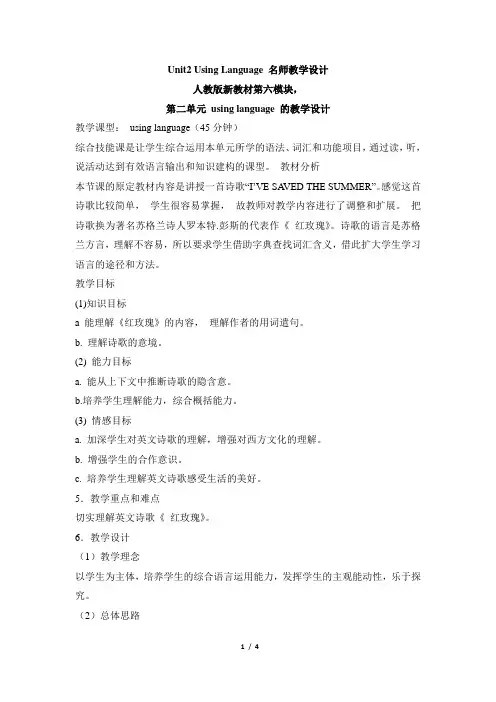
Unit2 Using Language 名师教学设计人教版新教材第六模块,第二单元using language 的教学设计教学课型:using language(45分钟)综合技能课是让学生综合运用本单元所学的语法、词汇和功能项目,通过读,听,说活动达到有效语言输出和知识建构的课型。
教材分析本节课的原定教材内容是讲授一首诗歌“I’VE SA VED THE SUMMER”。
感觉这首诗歌比较简单,学生很容易掌握,故教师对教学内容进行了调整和扩展。
把诗歌换为著名苏格兰诗人罗本特.彭斯的代表作《红玫瑰》。
诗歌的语言是苏格兰方言,理解不容易,所以要求学生借助字典查找词汇含义,借此扩大学生学习语言的途径和方法。
教学目标(1)知识目标a 能理解《红玫瑰》的内容,理解作者的用词遣句。
b. 理解诗歌的意境。
(2) 能力目标a. 能从上下文中推断诗歌的隐含意。
b.培养学生理解能力,综合概括能力。
(3) 情感目标a. 加深学生对英文诗歌的理解,增强对西方文化的理解。
b. 增强学生的合作意识。
c. 培养学生理解英文诗歌感受生活的美好。
5.教学重点和难点切实理解英文诗歌《红玫瑰》。
6.教学设计(1)教学理念以学生为主体,培养学生的综合语言运用能力,发挥学生的主观能动性,乐于探究。
(2)总体思路本节课采用多媒体教学,以此来创设良好的教学情景,优化教学过程,促进学生思考,创设学习情景,设计层层推进的教学任务,拓展了话题的深度和广度,促进师生之间,生生之间充分的交流和合作,使学生能主动学习、主动探究和主动构建知识。
采用教师指导下的小组合作学习的方法,启发学生自主理解文本内容,探究和领会作者的意图和了解西方文化。
最后在阅读和听力的语言输入的基础上让学生将英文诗歌《红玫瑰》的翻译和意境图汇报给全班。
(3)教学过程Step one Leading inShow students a picture of rose and ask them “what do them think of when they see the picture?Have the students express their ideasStep two Presentation1. ListeningListen to the poem and answer questions Can you guess what is the poem about? Does the poem have a rhythmic pattern?Does the poem have the rhyming words. What do you think of the language?Do you think the speaker is a boy or a girl?2. Group work –language1) Form a group of six.2) Four of you will be responsible for looking up the unfamiliar words in each part using your dictionaries.3) Explain your findings to the others .4) One write them down and one report them to class.3. Group work ---poetic devices(诗歌的手法)What are the rhyming words in each part? How does rhythmic pattern of the poem form4. Group work ---comprehension1) What does the author compare his girlfriend to and why?2) What does the author want to convey in the second and third part and how?3) What will happen in the last part?4) Poets often create images in the poem so that the readers can see pictures in theirminds. What is the picture of the poem?5. The background of Robert Burns.Robert Burns (1759 –1796) was a Scottish poet and a lyricist . (歌词作者)He is widely regarded as the national poet of Scotland . He is the best known of the poets who have written in the Scots language.Step Three Consolidation Group work --- translation1) Try to translate the poem into Chinese.2) Draw the picture that the author wants to create.3) Make the presentation to the class.【设计说明】该教学步骤旨在加深学生对该诗歌的理解。
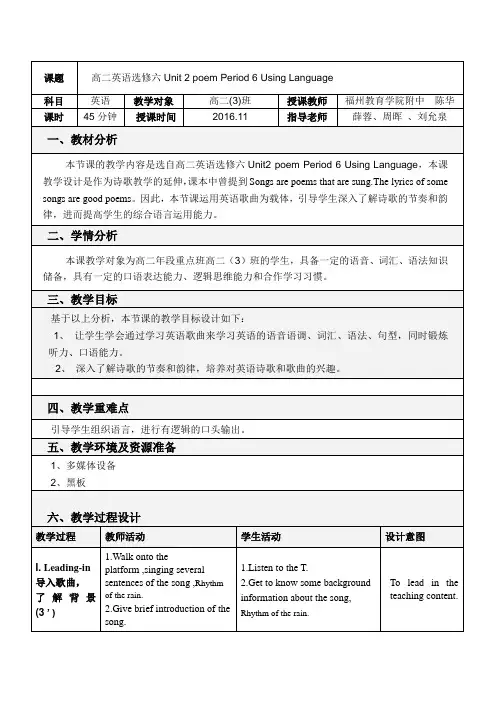

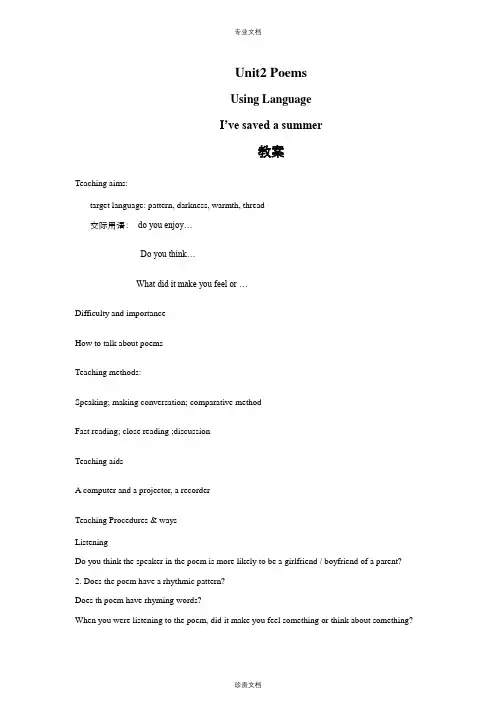
Unit2 PoemsUsing LanguageI’ve saved a summer教案Teaching aims:target language: pattern, darkness, warmth, thread交际用语:do you enjoy…Do you think…What did it make you feel or …Difficulty and importanceHow to talk about poemsTeaching methods:Speaking; making conversation; comparative methodFast reading; close reading ;discussionTeaching aidsA computer and a projector, a recorderTeaching Procedures & waysListeningDo you think the speaker in the poem is more likely to be a girlfriend / boyfriend of a parent? 2. Does the poem have a rhythmic pattern?Does th poem have rhyming words?When you were listening to the poem, did it make you feel something or think about something?What did it make you feel or think about?Step 2: poem appreciationRead the poem after the tape, and circle the words that rhyme.What is unusual about the rhyming words in the last four lines?3.listen to the poem and clap the strong beatStep three discussion1. who is the speaker in the poem and who is he/she speaking to? Give your reason2. which of the following is the closest to the speaker’s message? Give your reason for your choiceA. if it’s cold, I’ll warm you; if it’s dark, I’ll give you light; if you are hungry, I’ll feed you; if yo u want love, I’ll give it to youB. although the future may be difficult for you, whenever you need warmth and love, remember I’ll have some to give youC. While you’re away, I’ll remember your smile and I’ll love you always, when you return, I hope you will love me.Step four: word study1 pattern n. (1)图案;花样(2)方式(3)式样模型你可以用这个纸样儿做一套衣服。
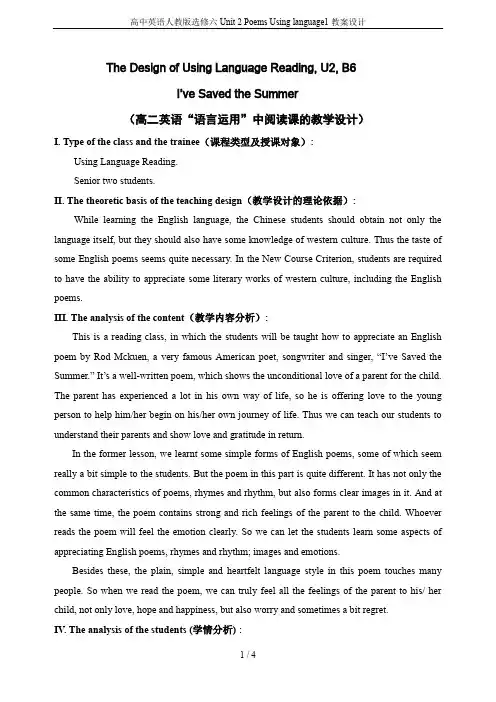
The Design of Using Language Reading, U2, B6I’ve Saved the Summer(高二英语“语言运用”中阅读课的教学设计)I. Type of the class and the trainee(课程类型及授课对象):Using Language Reading.Senior two students.II. The theoretic basis of the teaching design(教学设计的理论依据):While learning the English language, the Chinese students should obtain not only the language itself, but they should also have some knowledge of western culture. Thus the taste of some English poems seems quite necessary. In the New Course Criterion, students are required to have the ability to appreciate some literary works of western culture, including the English poems.III. The analysis of the content(教学内容分析):This is a reading class, in which the students will be taught how to appreciate an English poem by Rod Mckuen, a very famous American poet, songwriter and singer, “I’ve Saved the Summer.” It’s a well-written poem, which shows the unconditional love of a parent for the child. The parent has experienced a lot in his own way of life, so he is offering love to the young person to help him/her begin on his/her own journey of life. Thus we can teach our students to understand their parents and show love and gratitude in return.In the former lesson, we learnt some simple forms of English poems, some of which seem really a bit simple to the students. But the poem in this part is quite different. It has not only the common characteristics of poems, rhymes and rhythm, but also forms clear images in it. And at the same time, the poem contains strong and rich feelings of the parent to the child. Whoever reads the poem will feel the emotion clearly. So we can let the students learn some aspects of appreciating English poems, rhymes and rhythm; images and emotions.Besides these, the plain, simple and heartfelt language style in this poem touches many people. So when we read the poem, we can truly feel all the feelings of the parent to his/ her child, not only love, hope and happiness, but also worry and sometimes a bit regret.IV. The analysis of the students (学情分析) :After learning the Reading passage, the students have already tasted some simple forms of English poems. They have known some different forms of English poems and have become familiar with the characteristics of each kind of poems. But they can only understand the superficial meaning of these poems. And some of them think English poems are too easy and are not worth reading or appreciating. So in this period, while learning the poem, “I’ve Saved the Summer”,we will lead them to understand the poem, and meanwhile, we will teach them how to appreciate the English poems in different aspects, that is, from the point of rhymes and rhythm; images and emotions, which will really help them understand the poem better and in a higher level.V. Teaching objectives(教学目标):A. Help the students understand the inner meanings of the poem.B. Help the students learn to appreciate English poems.C. Help the students feel the unconditional love of a parent.D. Help the students learn to write their own poems after learning it.VI. Teaching important points (教学重点) :A. How to understand the inner meaning of the poem.B. How to appreciate the English poem.C.Pay special attention to rhymes and rhythm; images and emotions while reading anEnglish poem.VII. Teaching difficult points (教学难点) :A.How to appreciate an English poem.B.How to fully understand the meaning of this poem.VIII. Teaching methods (教学方法) :Student-centered and cooperative learning methods.IX. Teaching aids(教学媒体)Multi-media and Blackboard.X. Teaching procedure (教学过程) :Step 1 Revision (复习):1. Lead the students to review the five different forms of English poems in the reading passage:nursery rhymes, list poems, cinquain, haiku and Tang poems.(引导学生回忆在前一篇课文中学过的五种简单的英语诗歌的类型:童谣、清单诗、五行诗、俳句和唐诗)2. Show the students some poems and ask them to tell what kind of poems they are and whatcharacteristics they have. (给出几首诗,让学生判断每首诗的类型,并说出其特点) Step 2 Listen to part of the song “Seasons in the Sun”, a song by Rod Mckuen.(听“Seasons in the Sun”这首歌的一部分,引出本节课要学习的诗歌及诗作者)1. Listen and feel the rhymes and the rhythm.2. Introduction to Rod Mckuen.Step 3 Learning the poem(学习诗歌):1. Listen to the poem and answer (听诗歌朗诵):What came into your mind when you listened to the poem?2. Discussion (讨论):1) Who is likely to be the speaker in the poem and who is he /she speaking to?Give reasons to support your answer.2) Do a multiple choice exercise to further check the students’ understanding of the poem. Step 4 Appreciating the poem(诗歌欣赏):1. In what aspects can we appreciate poems (听诗歌朗诵并讨论:我们通常从哪些方面来欣赏英语诗歌)?1)rhymes, rhythm 2) images (意象) 3) emotions2. Read and find out the rhyming words(读诗歌,并找出押韵的词):you // new; need // feed; nineteen // mean; way // day; own // own.3. Listen and find out the two strong beats in each line. Then ask the students to read ittogether to further feel the strong beats(听诗歌找节奏,并让学生朗读).4. Imagery appreciation (意象欣赏)Lead the students to read the first two strophes and imagine the images in each part.(引导学生阅读诗歌的第一、二节,体会其中描述的画面)1) Let the students read the first strophe and feel what images they can have.Summer, winter mornings, and snow.2) Let the students read the first strophe and feel what images they can have.Sunlight and darkness.5. Emotion tasting (情感欣赏)Lead the students to read from the third strophe to the fifth one to feel the emotions implied in this poem. (引导学生学习诗歌的第三节至第五节,体会其中的深刻情感)1) Read the third strophe and answer:a. What has the parent kept?b. What do brave young smiles mean to the parent?2) Read the fourth strophe and answer:a. Can the parent help the child all his life?b. What does “way” mean?c. How can the child find the answers?3) Read the last strophe:a. Do the two “owns” have the same meaning?b. Fill in the blank:Step 5 Appreciating the language style of this poem (欣赏本首诗歌的语言风格): Ask the students to read the poem again and feel the language style of it.(让学生再次朗读诗歌,感受诗歌的写作风格)plain(平实的), not magnificentsimple, not complicatedheartfelt, not untruthfulStep 6 Group Discussion(小组讨论)1. How do your parents usually show their love to you? What about you?(你的父母是如何向你表达他们对你的爱的?你又是如何向他们表达你的爱的?)2. What will you do to convey your gratitude and love to your parents?(作为孩子,你打算怎么做去向你的父母表示你对他们的感激之情和深深地爱意?) Assignment1. Read and recite the poem “I’ve Saved the Summer” and try to translate it into Chinese.2. Surf the internet and find more English poems to appreciate.3. Try to write your own English poem.。
![人教新课标选修6 Unit2 Poems[教案]](https://uimg.taocdn.com/ac17b2134431b90d6c85c70a.webp)
Unit 2 PoemsⅡ. 目标语言Ⅲ. 教材分析与教材重组1. 教材分析本单元以Poems为话题,从学生初次接触诗歌,一直谈到诗歌创作的动机、有关诗歌的一些基本知识(包括诗歌的种类、风格)等。
旨在通过本单元的学习,使学生在初步了解和掌握诗歌这一文学形式的基本常识的基础上,进行简单的诗歌创作。
1.1 Warming Up部分要求学生回顾所学诗歌,启发学生以小组活动形式分析、列举人们进行诗歌创作的原因。
1.2 Pre-reading 部分首先要求学生说出自己最喜欢的中英文诗歌并阐明理由;然后通过快速阅读Reading部分内容填写列表,区分诗歌种类。
1.3 Reading部分是一篇介绍诗歌基础知识的文章。
文章从诗歌创作的动机、种类、特点及读者对象等方面简要介绍了五种不同风格、特色的诗歌。
1.4 Comprehending 部分根据阅读内容设置了三个习题。
第一个习题要求学生通过读文章、听录音感受诗歌特色,判断自己所喜欢的诗歌类型并说出理由;第二个习题就文章总体内容提出了五个问题,帮助学生进一步了解不同类型诗歌的不同特点;第三个习题通过十一个具体问题考查学生对文中某些细节内容的理解并要求分析诗歌创作者的情感、态度。
1.5 Learning about Language分words and expressions和structures两部分。
第一部分设置了两个练习:第1个练习要求从所学诗歌中找出与所给词汇压韵的词并添加其它韵词;第2个练习要求用所给词汇的正确形式填空。
第二部分通过四个小练习对所学诗歌中出现的两种结构形式进行训练。
1.6 Using Language共设置了三个任务:第一项任务通过一首小诗展开听力、口语、阅读训练,加深学生对诗歌韵律知识的理解;第二项任务通过Miss Jiang与学生谈论诗歌竞赛的一段录音学习,练习“意愿(intentions)”的表达。
第三项任务要求学生运用所学诗歌知识,根据所给提示进行模仿习作训练。

人教版高中英语选修6《Unit 2 Poem s》教案2篇Teaching plan of unit 2 Poems编订:JinTai College人教版高中英语选修6《Unit 2 Poems》教案2篇前言:英语作为在许多国际组织或者会议上都是必需语言,几乎所有学校选择英语作为其主要或唯一的外语必修课。
英语教学涉及多种专业理论知识,包括语言学、第二语言习得、词汇学、句法学、文体学、语料库理论、认知心理学等内容。
本教案根据英语课程标准的要求和教学对象的特点,将教学诸要素有序安排,确定合适的教学方案的设想和计划、并以启迪发展学生智力为根本目的。
便于学习和使用,本文档下载后内容可按需编辑修改及打印。
本文简要目录如下:【下载该文档后使用Word打开,按住键盘Ctrl键且鼠标单击目录内容即可跳转到对应篇章】1、篇章1:人教版高中英语选修6《Unit 2 Poems》教案2、篇章2:人教版高中英语选修6《Unit 2 Poems》教案篇章1:人教版高中英语选修6《Unit 2 Poems》教案教学准备教学目标教学目标(Teaching Aims)知识与技能(Knowledge and Skills)1.了解教学大纲关于语法填空的命题特点。
2.能够根据语法填空的命题特点自己编语法填空的题目3.掌握语法填空的解题方法与技巧过程与方法(Process and Methods)让每一位同学都能参与到课堂教学与活动中来,以小组或结对的形式进行相互学习和讨论。
情感态度与价值观(Feeling, Attitudes and Values)学习应对语法填空是与课文相结合,让学生在了解各种不同诗歌形式的背景下学习语法填空的设题与解题特点,从而更加理解英语诗歌的特色,更加懂得如何阅读和欣赏英语诗歌。
教学重难点教学重点(Important Points):1.让学生了解语法填空的命题特点2.掌握语法填空的解题方法与技巧教学难点(Difficult Points):语法填空中词性的转换教学过程(Teachers’ Activities)Step I: Lead-in① Review the new words and expressions of this unit by them together, and then do Task 1---speak out the other forms according to the giv en words② Listen to the song Jingle Bells and try tofill a word into each blank.Step II : Pre-practising1.Questions① Do you think it is difficult to complete the items of blank-filling with grammar knowledge?② Have you figur ed out the characteristics of the item?2.ExplainingIn this item there are 10 blanks for you to fill in with less than one proper word① some blanks with a given word while otherswith none② fill in the blanks with the proper form of the given word according to its grammatical and logical meaning.③ choose a preposition, pronoun, conjunction or an article to fill in the blank without any given word.3.DiscussionHow can we finish the items step by step with our grammar knowledge?① ___________________________________________.② _ __________________________________________.③ ___________________________________________.Step III : While-practising1.Making an item of grammatical blank-filling based on the para graph of the text.① more than 5 blanks.② some blanks with given word.③ others with none.2.exchange the item you made for your partner to complete it .3.The whole class finis h the one the teacher prepared for them.Step IV : Post-practising1.Check some of the students’ anwsers and give comments.2.Draw a conclusionStep V: Homework Assign ment1.Further improve your skills of dealing with the grammar filling.plete Ex.2 on Page 10, Nanfang New Class篇章2:人教版高中英语选修6《Unit 2 Poems》教案【按住Ctrl键点此返回目录】教学准备教学目标Teaching goals1.Target languagea. Important words and phrasesPoem, poetry, recite, aspect, convey, nursery, rhyme, diamond, cottage, balloon, sparrow, tease, salty, endless, translate, nursery rhyme, take it easy, run out of, make up ofb. Important sentencesWhich poem is about things that don’t make sense?Poets use many different forms of poems toexpress themselves.I hadn’t taken my eye off the ball.We hadn’t taken it easy.The poem is made up of five lines.A lot of Tang poetry has been translated into English. The translations have a free form that English people like to copy.2.Ability goalsa. Enable Ss to talk about different types of poems: nursery rhymes; list poems; cinquain,; haiku; Tang poemsb. Enable Ss to talk about different purposes of writing poems.c. Understand the main theme of each poem.d. Enable Ss to chant some of their favorite poems.3.Learning abilityEnable Ss to distinguish different types of poems 教学重难点Teaching important points1.Talk about five main types of poems.2.Understand the main purpose of writing the poems.Teaching difficult points1.Find the rhythm of each poem.2.Chant the poem.3.Understand the main purpose of writing the poems.教学过程Teaching procedures to share a feeling or experience; to describe something in detail or give an impression; to get the reader to think about an idea; to express a point of view; to make the reader experience the sight, sounds, smells, feel and tastes of something; to create a mood, to play with words--- their sounds, rhyme and rhythm.)If time permits, in small groups or as a class, discuss the kinds of topics that poets write about.( people, animals, nature, landscapes, the sea, the seasons, stories, death, war, youth and old age,feeling and experiences, emotions like love, hate, sadness, regret and desire, etc.)Step 4.Pre-readingPeople from different countries write different kinds of poems. Get Ss to discuss the questions on Page 9 with their partners: Do you have a favorite poem in Chinese? Why ? Do you have a favorite poem in English? Why?As to exercise 2, give Ss practice in animportant reading skill: scanning a text, that is, looking through a text quickly to find specific information. Read the table in exercise 2 with the Ss. Tell them that they are going to look for the information in the table, just in the poems themselves, not in the other parts of the text. They are to look only for those pieces of information and not readevery word. Do an example with them.Suggested answers to exercise 2:Step 5.ReadingScanningGet the Ss to read the passage quickly and accurately and meanwhile help the Ss to form a good habit of reading. Teacher gives Ss a couple of minutes to look through the whole passage. Tell them to read the text silently and then ask some detailed questions about the text on the slide show . Teacher should encourage Ss to express their ideas.Q1.Why do people write poetry?Q2.How many forms of poems are mentioned in the passage? What are they?Q3.What does “nursery rhyme” mean? Why do they delight small children?Q4.What’s the characteristic of “list poems”? What about “cinquain”?Q5.Why do English People like “Haiku”?Q6.Are you familiar with Tang Poems? Do you know the title of the last poem in the text?ListeningBefore Ss read the text, have them close their books and listen to the text with their eyes closed. This gives Ss the opportunity to listen to the sounds or “music” of the poems before reading them in detail. Tell them that it doesn’t ma tter if they don’t understand every word.First readingGet Ss to read the text carefully, finding the one sentence that sums up the paragraph of each part.. Underline the topic sentence.Second readingTell Ss that they are going to look at the rhythm of two of the poems. Make sure they know what rhythm is. Read the limerick aloud and have Ss listen for the strong beats. Then have them clap the strong beats asyou read. Mark the strong beats on the limerick on the board.There was an old man with a beardWho said “it is just as I feared”.“Four insects and thenTwo birds and a henHave all made a home in my beard”.Now read the poem A & B. Ask them to mark the strong beats on the two poems that have a strong rhythm. Check their answers . Then play the tape and get them to clap to the strong beats in those two poems.Third readingJust as any scene can serve as the subject of a painting, so any part of daily life can provide material for a poem.. Of course, the choice that the artist or poet makes relates to his or her purpose. Poetry is usually short and compact, so it should beread several times, preferably aloud, to appreciateits meaning. Read the last poem (Poem H), and answer the following questions:Q1.What parts of the poem suggest that the woman loves her husband?Q2.How do you understand the sentence” Shouldthe journeyer return, this stone would utter speech.”? Explain the sentence in your own words.Q3.What picture do you have in your mind when you read the above sentences?Q4.Do you know the Chinese title of this poem? Do you know the Chinese version of the poem?Step 6.Make a short summary of this period.课后习题Homework1.Surf some websites to find out more information about poets.2.Review the content of the reading passage.3.Finish the exercises on Page 12& 13.-------- Designed By JinTai College ---------。
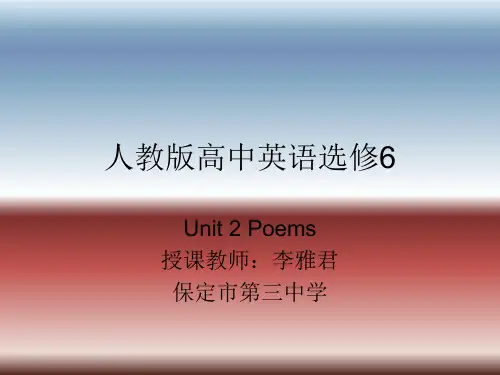
高中英语选修6《Unit 2 Poems》教案人教版高中英语选修6《Unit 2 Poems》教案人教版猜测是培养学生阅读能力的方法之一,因此笔者首先提出问题引发学生思考,对未来生活的各个方面进行预测。
其次通过快速阅读的方式,了解文章梗概,把握文章线索,找出文中对未来生活变化的描写,培养学生快速阅读的技巧与能力,并对未来生活变化的好坏进行小组讨论,培养集体协作精神。
下面和本文库一起看看有关高中英语选修6《Unit 2 Poems》教案人教版。
人教版高中英语选修6《Unit 2 Poems》教案1教学准备教学目标Teaching goals1. Target languagea. Important words and phrasesPoem, poetry, recite, aspect, convey, nursery, rhyme, diamond,cottage, balloon, sparrow, tease, salty, endless, translate, nursery rhyme, take it easy, run out of, make up ofb. Important sentencesWhich poem is about things that don’t make sensePoets use many different forms of poems to express themselves.I hadn’t taken my eye off the ball.We hadn’t taken it easy.The poem is made up of five lines.A lot of Tang poetry has been translated into English. The translations have a free form that English people like to copy.2. Ability goalsa. Enable Ss to talk about different types of poems: nursery rhymes;list poems; cinquain,; haiku; Tang poemsb. Enable Ss to talk about different purposes of writing poems.c. Understand the main theme of each poem.d. Enable Ss to chant some of their favorite poems.3. Learning abilityEnable Ss to distinguish different types of poems教学重难点Teaching important points1. Talk about five main types of poems.2. Understand the main purpose of writing the poems.Teaching difficult points1. Find the rhythm of each poem.2. Chant the poem.3. Understand the main purpose of writing the poems.教学过程Teaching procedures … waysStep 1. GreetingsStep 2. PresentationAsk Ss to think back and try to remember poems from their early childhood, either in Chinese or in English.Talk about some famous poets both home and abroad, either ancient ones or modern ones.Brainstorming: What will you think of when we talk about the word "poem"Step 3. Warming upRead the questions in this part, reminding Ss what they notice about the above poems.(e.g. they have a strong beat, or they have rhyme, or they play with words and sounds, or perhaps some of them are funny because they make no sense.)Tell Ss that there are many reasons why people write poetry. Give the examples on the Bb. Ask Ss why they think the poets wrote the poems they have just recited.. Write their suggestions on the board.Give Ss a time limit of a few minutes. Divide the class into groups of four to discuss the purpose of writing poems. Ask one person from each group to read their group’s list and add their suggestions to the list on the board. (Suggested reasons: to create certain feelings or images in the reader; to share a feeling or experience; to describe something in detail or give an impression; to get the reader to think about an idea;to express a point of view; to make the reader experience the sight,sounds, smells, feel and tastes of something; to create a mood, to play with words--- their sounds, rhyme and rhythm.)If time permits, in small groups or as a class, discuss the kinds of topics that poets write about.( people, animals, nature, landscapes,the sea, the seasons, stories, death, war, youth and old age, feeling and experiences, emotions like love, hate, sadness, regret and desire,etc.)Step 4. Pre-readingPeople from different countries write different kinds of poems. Get Ss to discuss the questions on Page 9 with their partners: Do you have a favorite poem in Chinese Why Do you have a favorite poem in English WhyAs to exercise 2, give Ss practice in an important reading skill: scanning a text, that is, looking through a text quickly to find specific information. Read the table in exercise 2 with the Ss. Tell them that they are going to look for the information in the table, just in the poems themselves, not in the other parts of the text. They are to look only for those pieces of information and not read every word. Do an example with them.Suggested answers to exercise 2:Step 5. ReadingScanningGet the Ss to read the passage quickly and accurately and meanwhile help the Ss to form a good habit of reading. Teacher gives Ss a couple of minutes to look through the whole passage. Tell them to read the text silently and then ask some detailed questions about the text on the slide show . Teacher should encourage Ss to express their ideas.Q1. Why do people write poetryQ2. How many forms of poems are mentioned in the passage What are they Q3. What does "nursery rhyme"mean Why do they delight small childrenQ4. What’s the characteristic of "list poems"What about "cinquain"Q5. Why do English People like "Haiku"Q6. Are you familiar with Tang Poems Do you know the title of the last poem in the textListeningBefore Ss read the text, have them close their books and listen to the text with their eyes closed. This gives Ss the opportunity to listen to the sounds or "music" of the poems before reading them in detail. Tell them that it doesn’t matter if they don’t understand every word. First readingGet Ss to read the text carefully, finding the one sentence that sums up the paragraph of each part.. Underline the topic sentence.Second readingTell Ss that they are going to look at the rhythm of two of the poems. Make sure they know what rhythm is. Read the limerick aloud and have Ss listen for the strong beats. Then have them clap the strong beats as you read. Mark the strong beats on the limerick on the board.There was an old man with a beardWho said "it is just as I feared"."Four insects and thenTwo birds and a henHave all made a home in my beard".Now read the poem A … B. Ask them to mark the strong beats on the two poems that have a strong rhythm. Check their answers . Then play the tape and get them to clap to the strong beats in those two poems.Third readingJust as any scene can serve as the subject of a painting, so any part of daily life can provide material for a poem.. Of course, the choice that the artist or poet makes relates to his or her purpose. Poetry is usually short and compact, so it should be read several times, preferably aloud, to appreciate its meaning. Read the last poem (Poem H), and answer the following questions:Q1. What parts of the poem suggest that the woman loves her husband Q2. How do you understand the sentence" Should the journeyer return,this stone would utter speech." Explain the sentence in your own words. Q3. What picture do you have in your mind when you read the above sentencesQ4. Do you know the Chinese title of this poem Do you know the Chinese version of the poemStep 6. Make a short summary of this period.课后习题Homework1. Surf some websites to find out more information about poets.2. Review the content of the reading passage.3. Finish the exercises on Page 12… 13.人教版高中英语选修6《Unit 2 Poems》教案2教学准备教学目标教学目标(Teaching Aims)知识与技能(Knowledge and Skills)1. 了解教学大纲关于语法填空的命题特点。
Unit 2 Poems第6课时教案——Using language: writing practice磐安县第二中学应旭旭一、教学目标知识与技能:1.能了解、运用基本的诗歌鉴赏的基本方面和策略。
2.能根据话题情境编写简单的小诗。
过程与方法:能在小组讨论的过程中,训练发散性思考,提升思辨能力。
情感态度与价值观:能够通过诗歌的学习和创作生发对父母的感恩之情,勇于表达对父母的爱。
二、教学重难点教学重点:1.能了解、运用基本的诗歌鉴赏的基本方面和策略。
2.能根据话题情境编写简单的小诗。
教学难点:能在小组讨论的过程中,训练发散性思考,提升思辨能力。
三、学情分析该单元的话题是诗歌,关于该主题学生并不陌生,在学习的生涯中,他们已经接触过各种各样的诗歌类型,也掌握了诗歌的一些基本鉴别方法。
但是这都局限于中文,对于英语诗歌,可能很多同学都是第一次接触,所以不可避免地会有点陌生。
所以要让学生快速进入到诗歌的学习中,就要帮助学生进行顺利地中英文学习迁移,那么其中的桥梁就是诗歌鉴赏的几个基本方面:韵律、意象和情感。
从这几个方面牵线搭桥能够帮助学生更快地明白中英文诗歌鉴赏其实有很多共通之处,减少学生对于陌生体裁的抗拒感。
同时,授课的班级为磐安县第二中学高二八班的同学,总的来说,班级的英语水平不是很够,教学设计如果过于复杂和深入就可能会导致学生没有任何反应。
因此,在教学的过程中一定要注意提问的设置,对于一些较难又必须要解决的问题要做好充分的铺垫和引导。
在任务的布置中,要充分发挥小组合作的力量,集思广益,降低任务的难度,又能使学生获得充分的成就感和满足感。
四、教学步骤Step1. Lead inIntroduce the story of Kongrong in the ancient time to the Ss, making them have a better understanding of the word “save”. Then give the students some examples of the usage of “save”and finally go down into the topic “I’ve saved the summer”.T: “At the beginning of our class let’s look at the picture. Do you know what’s the story about? Who is that little boy?”“Yes, he is Kongrong. And one day his father asked him to choose one of those pears. Which one did he choose, the bigger ones or the smallest one? Yes, he saved the bigger ones for his older brothers to show his love and respect to his brothers. We can save things we like for our beloved ones and we can also save time and money. Yeah, we can also save memories by taking photos. Have you ever heard of saving the summer? It’s amazing, right? Let’s learn today’s poem together.”设计意图:通过故事导入,让学生对小诗中的关键词save有一个更好的把握,能够体会出save与单纯的give之间存在的差别。
人教版高中英语选修六unit 2 poems教学设计教材分析人教版高中英语选修六Unit 2 Poems教学设计教材分析仇继日课时内容的处理与调整:本单元的中心话题是诗歌。
文中涉及诗歌的韵律、节奏,并介绍了几种不同内容和形式的简单诗歌。
为了让学生能对诗歌的认识和理解有一定的基础和鉴赏水平,笔者将本单元的课时安排进行了处理和调整。
第一课时听说训练,引导学生谈论对诗歌的喜好以及诗歌创作灵感的汲取;第二课时学习using language “ i’ve saved the summer ”, 让学生通过听读理解诗歌内容,辨认诗人的身份,体会感受,找出诗歌的韵律,并表达由诗歌所激起的联想。
继而,引导学生边打拍子边朗读,在欣赏中加深对诗歌的理解。
阅读后,由五个学习小组分别翻译该诗歌的五小节。
经过两个课时的学习,学生已经不惧怕诗歌,同时还有了创作的愿望。
在此基础上,笔者着手教学reading--- a few simple forms of englishpoems。
reading教学内容分析:该部分介绍了几种简单的英语诗歌。
第一段总括全文,阐述写诗的目的;第二段起,分析不同种类的诗歌,并举例说明。
它们分别是节奏明快、韵律和谐、不断重复、利于记忆;清单诗;五行诗;俳句和被译为英文的唐诗。
教学目标知识目标:引导学生了解诗歌相关的词汇及文章中的重点词汇。
能力目标:a、培养学生阅读策略和技巧,扫读查找信息,快速归纳文章大意,细读捕捉和完善信息b、朗读、理解和创作诗歌的能力 c、小组合作学习的能力情感、态度和价值观目标:热爱生活、热爱自然,欣赏和解读诗歌,发扬团结协作和积极向上的精神学情分析授课班级学生素质较好,具备一定的自主学习能力,特别是本学期年级开展学习合作互助小组以来,学生之间的合作精神、竞争意识都在一定程度上有了较明显的提升。
教学重难点:1、to get the ss to know the simple forms of english poems.2、to have a better understanding of poems3、to guide the ss to create poems 五、教学方法:小组合作探究、诗歌朗读、讨论法、竞赛活动六、教学用具:多媒体、黑板、音乐播放器、小音箱七、教学过程(teaching procedure)step 1、greetingsstep 2、lead in1. review the words, such as poet, poem, poetry, rhyme, rhythm , rhythmic etc.2. play the english song----- doe ri me 【设计思路】师生合唱英文歌曲,帮助学生更好了解押韵和节奏感的同时,有效地调动学生的学习热情。